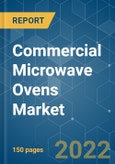The commercial microwave ovens market is poised to grow by USD 728.90 million in 2026, progressing at a CAGR of more than 3% during the forecast period, 2021-2026. The market has been negatively impacted due to the COVID-19 pandemic and the global lockdown. The lockdown led to restrictions on manufacturing activities and supply chains. The lockdown in China forced commercial microwave oven manufacturers based in the United States and Europe to temporarily halt production as they export several input supplies. This led to an increase in the supply and demand gap. The outbreak was expected to continue to have a negative impact on businesses throughout 2020 and into 2021.
Commercial microwave ovens have significant usage across the foodservice industry due to their multiple benefits such as expedited cooking process, cost-effectiveness, improved efficiency, and lesser time consumption. Modern-day commercial microwave ovens are highly programable and feature internal memory systems that can store up to 100 recipe settings. The digitized displays of these ovens help users conveniently explore various options and set timers, making them more accessible for employees and staff. Commercial microwave ovens are versatile and offer faster and more efficient cooking options for commercial foodservice establishments like restaurants, cafés, takeaways, etc. These devices are best suited for large-scale food operations for their beneficial uses in reheating food, quick defrosting, and a variety of cooking options. The rapidly burgeoning global demand for energy-efficient cooking methods is a key driver for the commercial microwave ovens market. The market growth can be attributed to a plethora of factors, such as the numerous advantages of commercial microwave ovens over traditional microwaves, like enhanced functionality and lesser energy and time consumption, the expanding foodservice industry (including restaurants, hotels, and cafés), the surging demand for microwave ovens across corporate firms and other commercial establishments, the rising popularity of foodservice outlets like food trucks and takeaways, the emerging cloud kitchen and online food delivery sector, the booming hospitality sector, and technological advancements in microwave ovens. Manufacturers are increasingly focusing on developing commercial microwaves with automatic timers for efficient cooking processes, which is a highly conducive factor for the market growth. The amplifying demand for frozen and ready-to-eat food items, improving living standards, rising disposable incomes, rapid urbanization, growing working population and their packed work schedules, and the soaring demand for catering services for seminars and social gatherings are other pivotal factors contributing to the market growth. However, commercial microwave ovens have certain disadvantages, such as rapid heating that often leads to overcooked food, improper container ventilation, and unevenly cooked food, causing cold spots. Such factors are expected to limit the demand for commercial microwave ovens to some extent. Moreover, high power consumption and increasing costs of these appliances act as key restraints for the global market growth.
Key Market Trends
The Demand for Energy-efficient Cooking Products is Driving the Market
Commercial kitchens, such as those found in full-service and quick-service restaurants, hotels, and hospitals, are intense energy users, consuming as much as three times more energy per square foot than most other types of commercial buildings. Since energy costs for these facilities typically account for around 25%-30% of the total operating expenses, upgrading equipment to be more energy-efficient can increase the bottom-line revenues while also providing significant non-energy benefits, including improved operating performance, more uniform cooking, and increased comfort of the kitchen staff. Commercial kitchen equipment, such as ovens, require energy to function. By purchasing energy-efficient equipment in new constructions or when existing equipment fails, one can significantly reduce the energy used in the kitchen, save money, and reduce the carbon footprint.
Asia-Pacific is Anticipated to Grow at the Highest Rate
Asia-Pacific is the fastest-growing market, and it is expected to record a significant growth rate over the forecast period, led by rapid commercialization and industrialization. The market growth is accredited to the region's flourishing food and hospitality industries, the rapidly expanding foodservice industry, increasing foodservice outlets, and several other favorable factors. The overall demand for and popularity of microwave ovens may increase in developing countries, such as China and India, owing to the growing inclination of customers toward high expenditures on first-rate kitchen electrical appliances. In the future, Japan is expected to achieve a considerable share in the market. Asia-Pacific is leading the industry due to rapid industrialization, an increasing number of industries, and developments in the electric and electronic industries. Advancements in technology and increased product innovations are among the key factors supporting this region’s market demand.
Competitive Landscape
The report covers the major international players operating in the commercial microwave ovens market. In terms of market share, a few of the major players currently dominate the market. However, with technological advancements and product innovations, mid-size to smaller companies are increasing their market presence by securing new contracts and tapping into new markets.
Additional Benefits:
- The market estimate (ME) sheet in Excel format
- 3 months of analyst support
This product will be delivered within 2 business days.
Table of Contents
Companies Mentioned (Partial List)
A selection of companies mentioned in this report includes, but is not limited to:
- Samsung
- LG
- Galanz
- Panasonic
- Midea
- Toshiba
- Electrolux
- Siemens
- Breville
- GE (Haier)
- Whirlpool
- Sharp
- Bosch
Methodology

LOADING...








